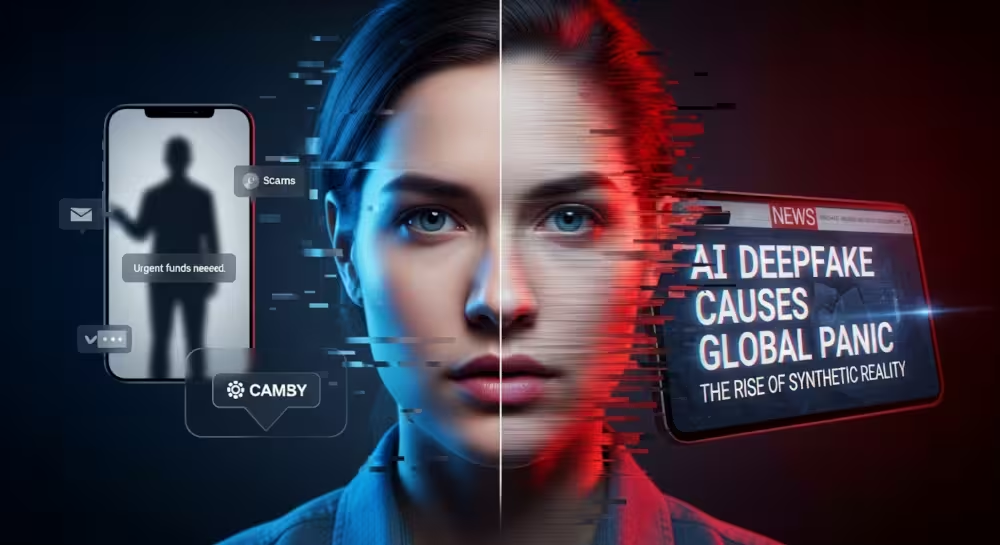AI Deception, Deepfakes, Scams, and the Battle for Trust

The intersection of AI and society is no longer a futuristic debate—it is today’s reality. Imagine waking up, scrolling through your phone, and seeing your favorite financial advisor or celebrity urging you to invest in a “once-in-a-lifetime opportunity.” It looks real, the voice is convincing, the gestures feel human. But here’s the twist: it never happened. You’ve just been tricked by an AI-generated deepfake scam.
In September 2025, the UK faced exactly this issue when financial expert Martin Lewis became the face of yet another AI-powered scam ad circulating online. This event reignited a fierce conversation about the ethical, legal, and social implications of AI in everyday life. And it poses an urgent question: how do we protect trust in a world where reality can be manufactured at will?
The Rise of AI Deepfake Scams

Deepfake technology, once a playful experiment for swapping faces in movies or generating funny memes, has grown into a multi-billion-dollar underground industry. Scammers now use AI to clone voices, replicate faces, and spread false messages at an alarming scale.
In the case of Martin Lewis, AI-generated videos portrayed him endorsing fake investment schemes. For an unsuspecting user, the scam looks legitimate because it borrows credibility from a real public figure. And this is not an isolated event—similar scams have appeared worldwide, targeting celebrities, politicians, and even private citizens.
The Financial Times recently highlighted how regulators are under pressure to address deepfake-related fraud, particularly after these high-profile cases (FT report).
Why Deepfakes Hit Society at Its Core
The problem with deepfakes goes beyond fraud. At its heart, it strikes at societal trust:
- Trust in institutions – If political leaders can be faked, how do we know what’s real during elections?
- Trust in media – With manipulated videos, fact-checking becomes harder, and misinformation spreads faster.
- Trust in individuals – Imagine a student accused because of a fake video, or an employee’s reputation ruined overnight.
This erosion of trust challenges the very foundation of modern democratic societies. A world where “seeing is believing” no longer holds true demands new ways of verification, new laws, and perhaps new habits from all of us.
Governments Respond: Laws and Regulations
Governments are now racing to keep up. In the UK, lawmakers have urged for tighter digital safety laws, targeting AI-generated scams specifically. Meanwhile, the European Union’s AI Act is setting global benchmarks, requiring transparency whenever AI is used in media or communication.
In the United States, the Federal Trade Commission (FTC) has begun investigating AI companies over potential misuse of generative models in advertising. These efforts point to one reality: without regulation, the scale of harm could surpass anything society has seen before in digital history.
The Role of Big Tech
It’s not just governments; tech giants have a responsibility too. Platforms like Meta, Google, and TikTok are under increasing scrutiny. While they claim to remove harmful deepfakes, the truth is that thousands slip through the cracks every day.
Interestingly, Google recently announced an AI watermarking tool, aiming to tag AI-generated content with invisible signatures. Microsoft, on the other hand, has begun testing real-time content authenticity labels. These innovations offer hope, but they also raise questions: will they be universally adopted, or will scammers simply find ways around them?
Society’s New Digital Literacy
If we zoom out, the deeper issue isn’t just technology—it’s societal adaptation. In the same way people learned to question spam emails in the early 2000s, we now need a collective upgrade in digital literacy.
- Schools may need to teach students how to spot deepfakes.
- Companies may need regular training for employees to avoid being misled.
- Everyday internet users may need to adopt a “trust but verify” mindset.
This cultural shift will take time, but it is essential if we want to coexist safely with AI.
Balancing Innovation and Protection
It’s tempting to see AI only as a threat, but that would be unfair. The same algorithms used to create deepfakes can also be harnessed to detect them. For instance, startups are emerging with AI-powered verification tools, capable of flagging suspicious videos before they spread.
Moreover, AI brings undeniable benefits in healthcare, education, and business. The challenge is not to abandon innovation but to balance progress with protection—ensuring that AI serves society without undermining its values.
A Glimpse into the Future
Let’s imagine two possible futures:
- The Dark Path – Deepfakes continue unchecked. Elections are influenced, reputations destroyed, and online scams become an everyday risk.
- The Responsible Path – Regulation, technology, and education align. Deepfakes exist, but society develops strong defenses, much like we did against spam or phishing.
Which future unfolds depends on the actions we take today.
The Fight for Truth
The Martin Lewis case may feel like just another online scam, but in reality, it symbolizes a turning point. AI in society is no longer just about convenience or efficiency—it’s about trust, ethics, and the very fabric of reality.
As individuals, we must stay vigilant. As societies, we must demand responsibility from both governments and tech companies. And as humans, we must never forget that truth, though fragile, is worth protecting.
For similar articles, please visit: AI and Society
Homepage / humanaifuture.com




